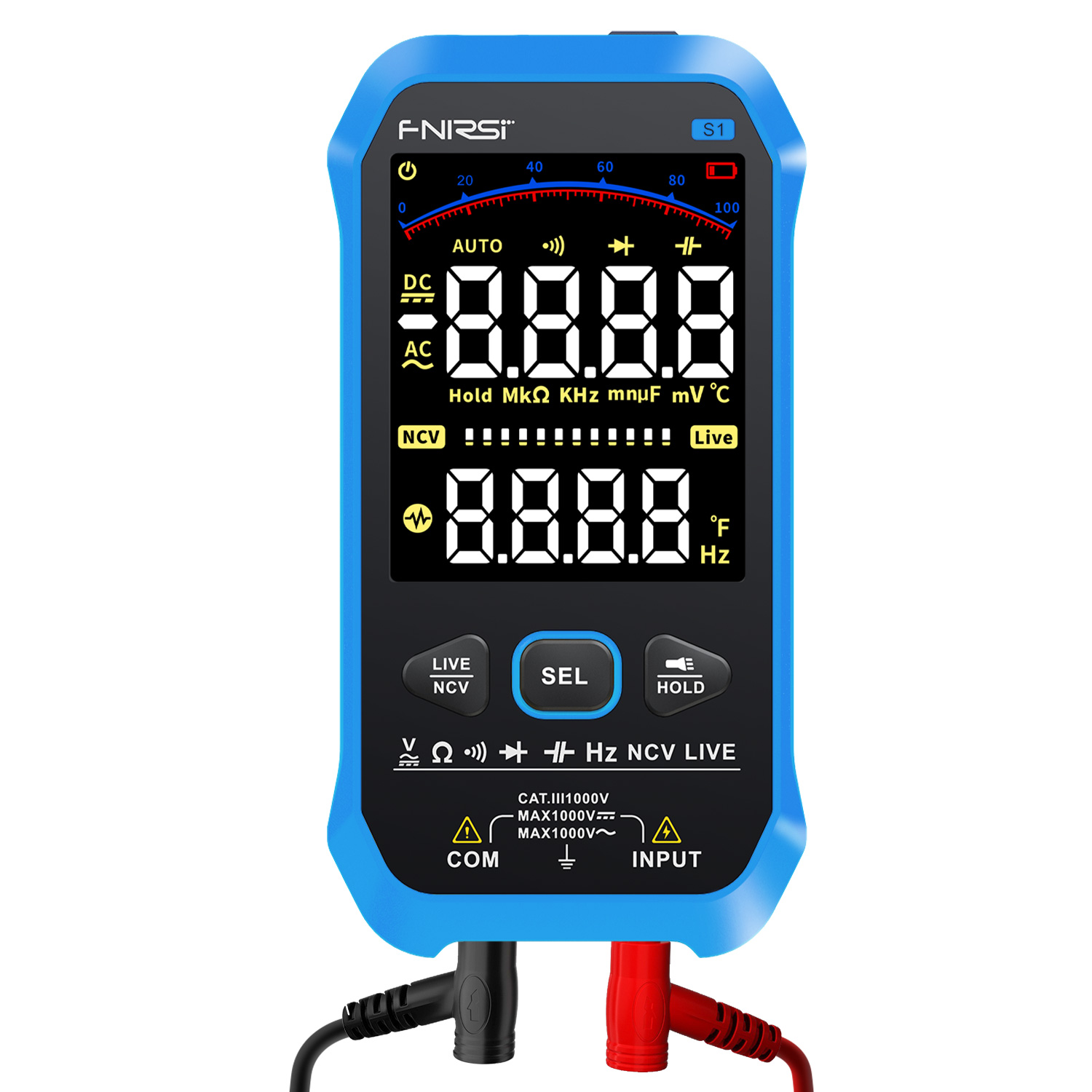
|
FNIRSI, known for its tablet oscilloscopes, has now also launched a multimeter, the S1. The device looks like a bulky smartphone and works almost entirely automatically. |
Introduction to the S1 from FNIRSI
What is the S1?
The S1 is a multimeter that almost fully automatically measures:
- DC voltages
- AC voltages
- Resistors
- Capacitors
- Frequencies
- Temperatures
You cannot measure currents with it, but that is a function you use least in practice. We don't think this is a major shortcoming. The large display has two number indicators up to 9999 that show both the rms value and the frequency when measuring AC voltages. When measuring temperatures, you will see the temperature in both °C and °F on these two indicators. The main indicator has digits with a height of 18 mm. There is also an analogue scale with a range of 0 to 100 % of the set range.
The nowadays apparently indispensable white LED on the back and the option for measuring the presence of 50 Hz fields near current-carrying conductors are also present in this multimeter.
The S1 has two special features. It is powered from a built-in rechargeable Li-ion battery that you can charge from a normal 5 V USB charger. The battery has a voltage of 3.7 V and a capacity of 1,000 mAh. The maximum charging current is 450 mA and the charging time is two hours. With charged battery, you can measure for about five hours. In addition, this meter includes the ability to calibrate the device individually.
Manufacturer, suppliers, prices
The S1 is marketed under the brand name FNIRSI by Chinese Shenzhen FNIRSI Technology Co. from (obviously) Shenzhen. You can order the device from all well-known mail-order companies like Banggood, Amazon, eBay and countless companies that sell their stuff via AliExpress. Prices vary slightly around 30 euros.
The appearance of the S1 multimeter
A lot of modern Chinese multimeters look like a smartphone, and the S1 is no exception. It measures 143 mm by 75 mm by 19 mm and weighs 134 g. The meter is not housed in a rubber protective case (like a lot of hand-held meters), but in a housing made of hard plastic. That case, however, fits well in the hand.
- Resistors
- Capacitors
- Frequencies
- Temperatures
You cannot measure currents with it, but that is a function you use least in practice. We don't think this is a major shortcoming. The large display has two number indicators up to 9999 that show both the rms value and the frequency when measuring AC voltages. When measuring temperatures, you will see the temperature in both °C and °F on these two indicators. The main indicator has digits with a height of 18 mm. There is also an analogue scale with a range of 0 to 100 % of the set range.
The nowadays apparently indispensable white LED on the back and the option for measuring the presence of 50 Hz fields near current-carrying conductors are also present in this multimeter.
The S1 has two special features. It is powered from a built-in rechargeable Li-ion battery that you can charge from a normal 5 V USB charger. The battery has a voltage of 3.7 V and a capacity of 1,000 mAh. The maximum charging current is 450 mA and the charging time is two hours. With charged battery, you can measure for about five hours. In addition, this meter includes the ability to calibrate the device individually.
Manufacturer, suppliers, prices
The S1 is marketed under the brand name FNIRSI by Chinese Shenzhen FNIRSI Technology Co. from (obviously) Shenzhen. You can order the device from all well-known mail-order companies like Banggood, Amazon, eBay and countless companies that sell their stuff via AliExpress. Prices vary slightly around 30 euros.
The appearance of the S1 multimeter
A lot of modern Chinese multimeters look like a smartphone, and the S1 is no exception. It measures 143 mm by 75 mm by 19 mm and weighs 134 g. The meter is not housed in a rubber protective case (like a lot of hand-held meters), but in a housing made of hard plastic. That case, however, fits well in the hand.
The two measurement inputs are at the bottom of the device, making it almost impossible to place the multimeter at an angle in a holder on your desktop. On the top is the 'ON/OFF' pushbutton and a USB-C connector for connecting the charger.
The 'SEL' pushbutton allows you to exit the automatic measuring mode and manually set the parameter to be measured. The 'HOLD' pushbutton freezes the reading. The white LED on the back of the meter lights up if you press this button for more than one second. With the 'LIVE/NCV' button, you select the option to find the hot wire of the mains or detect electrical conductors in the wall.
There is no possibility to set the measurement range manually, the meter determines the range that gives the best resolution.
After 15 minutes of inactivity, the meter switches off automatically.
There is no possibility to set the measurement range manually, the meter determines the range that gives the best resolution.
After 15 minutes of inactivity, the meter switches off automatically.
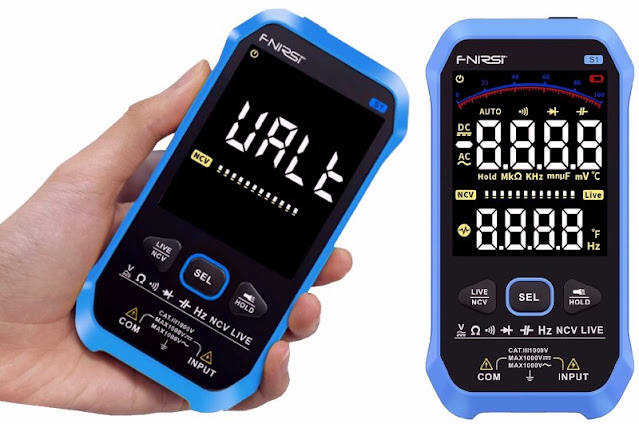 |
| The appearance of the FNIRSI S1 multimeter. (© 2023 Jos Verstraten) |
The scope of delivery of the S1 multimeter
The meter comes in a sturdy box, inside fitted with a thick foam layer where the meter is embedded. Under this layer is room for the test leads, charging cable and manual. According to the details at almost all vendors, a thermocouple cable would also be included, but this part was not present in our specimen (bought from Banggood).
 |
| The scope of delivery of the FNIRSI S1 multimeter. (© 2023 Jos Verstraten) |
The test leads
The test leads are the standard leads supplied with almost all Chinese multimeters. They have a length of 105 cm, are very flexible and the needle-shaped tip has a plastic protective jacket. The inscription '1000V ~ 20A' should be taken not too literally. The banana plugs are fully shielded and the lead is connected to that banana plug at a 90° angle. The measuring leads own resistance is about 75 mΩ (measured by us).
 |
| The supplied test leads. (© AliExpress) |
The manual
A 28-page booklet that clearly discusses all functions and specifications in Chinese and excellent English. If only all Chinese products had such a good manual! We scanned it and put it on our account at archive.org:
➡ FNIRSI_S1_Multimeter.pdf
The specifications of the FNIRSI S1 multimeter
According to the manufacturer, this multimeter has the following specifications:
- Measurement selection: automatic or manual
- DC voltage: 9.999 V accuracy ±(0.8% + 3), resolution 0.001 V
- DC voltage: 99.99 V, accuracy ±(0.8% + 3), resolution 0.01 V
- DC voltage: 999.9 V, accuracy ±(0.8% + 3), resolution 0.1 V
- AC voltage: 9.999 V, accuracy ±(0.8% + 3), resolution 0.001 V
- AC voltage: 99.99 V, accuracy ±(0.8% + 3), resolution 0.01 V
- AB voltage: 999.9 V, accuracy ±(0.8% + 3), resolution 0.1 V
- AC voltage frequency range: 50 Hz ~ 1 kHz
- AC measurement method: true RMS
- Resistance: 999.9 Ω, accuracy ±(0.8% + 3), resolution 0.1 Ω
- Resistance: 99.99 kΩ, accuracy ±(0.8% + 3), resolution 0.01 kΩ
- Resistance: 999.9 kΩ, accuracy ±(0.8% + 3), resolution 0.1 kΩ
- Resistance: 99.99 MΩ, accuracy ±(1.2% + 3), resolution 0.01 MΩ
- Capacitance: 9.999 nF, accuracy ±(4.5% + 5), resolution 0.001 nF
- Capacitance: 99.99 nF, accuracy ±(4.5% + 5), resolution 0.001 nF
- Capacitance: 999.9 nF, accuracy ±(4.5% + 5), resolution 0.1 nF
- Capacitance: 9.999 µF, accuracy ±(4.5% + 5), resolution 0.001 µF
- Capacitance: 99.99 µF, accuracy ±(4.5% + 5), resolution 0.01 µF
- Capacitance: 999.9 µF, accuracy ±(4.5% + 5), resolution 0.1 μF
- Capacitance: 9.999 mF, accuracy ±(4.5% + 5), resolution 0.001 mF
- Frequency: 9.999 Hz, accuracy ±(0.1% + 3), resolution 0.001 Hz
- Frequency: 99.99 Hz, accuracy ±(0.1% + 3), resolution 0.01 Hz
- Frequency: 999.9 Hz, accuracy ±(0.1% + 3), resolution 0.1 Hz
- Frequency: 9.999 kHz, accuracy ±(0.1% + 3), resolution 0.001 kHz
- Frequency: 99.99 kHz, accuracy ±(0.1% + 3), resolution 0.01 kHz
- Frequency: 999.9 kHz, accuracy ±(0.1% + 3), resolution 0.1 kHz
- Frequency: 9.999 MHz, accuracy ±(0.1% + 3), resolution 0.001 MHz
- Frequency sensitivity: 1.5 Vrms
- Temperature: -20 °C ~ +400 °C, accuracy ±(5% + 4), resolution 1°C
- Diode measurements: Yes, up to 3.2 V with 1 mA
- Built-in buzzer: Yes
- Data hold function: Yes
- Low-voltage indicator: Yes
- NCV function: Yes
- Built-in lighting: Yes
- Auto-off function: Yes, after ±15 minutes
- Measurement speed: 3 measurements per second
- Dimensions: 143 x 75 x 19 m
- Weight: 134 g
The automatic operation
In the advertisements, the S1 is called 'smart' because it is said to be fully automatic. In the manual, this claim is toned down slightly. The meter can automatically switch between DC voltage, AC voltage, resistance and continuity (diode). However, you have to select the other functions manually. The meter obviously does not notice that you connect a capacitor to the inputs or that you want to measure a frequency.

The calibration option
This option is not described in the manual, but has been documented on several sites on the internet. The prerequisite is that you have access to a number of standards, such as a very accurate 5,000 V voltage reference, a pair of resistors with a tolerance of ±0.1% and capacitors with a tolerance of ±1.0%.
The automatic operation
In the advertisements, the S1 is called 'smart' because it is said to be fully automatic. In the manual, this claim is toned down slightly. The meter can automatically switch between DC voltage, AC voltage, resistance and continuity (diode). However, you have to select the other functions manually. The meter obviously does not notice that you connect a capacitor to the inputs or that you want to measure a frequency.

The calibration option
This option is not described in the manual, but has been documented on several sites on the internet. The prerequisite is that you have access to a number of standards, such as a very accurate 5,000 V voltage reference, a pair of resistors with a tolerance of ±0.1% and capacitors with a tolerance of ±1.0%.
To enable this option, connect the test leads unloaded, hold down the 'SEL' pushbutton and switch on the multimeter. After a second press on the 'SEL' pushbutton, the word 'CAL' appears in the display.
The calibration sequence then starts. Since you undoubtedly do not have any of the necessary parts at home, we will not go into further detail here. As will be shown, the meter is accurate enough for almost all hobby work and calibration is not necessary.
The electronics in the FNIRSI S1 multimeter
Unscrew the housing
The black back of the case is attached to the front with four small screws. Afterwards, use a knife to carefully pry into the gap between the sides to separate the two parts. This is because these are snapped together by means of some spring-loaded tabs. You can then remove the back and the internal electronics come into view.
The largest component is obviously the battery which is attached to the circuit board with very well adhesive double-sided tape. The two 4 mm input terminals are soldered directly to the PCB. On the top right, you can see the buzzer. The white block is a relay that you can often hear switching when measuring. To the left of the buzzer is a TM1621B chip from Titan Micro Electronics. That is a 32 x 4 LCD driver that provides communication to the display.
 |
| The internal of the FNIRSI S1 multimeter. (© 2023 Jos Verstraten) |
The microcontroller
The 'brain' of this multimeter is a DTM0660L chip from Dream Tech. This chip is the heart of a lot of cheap Chinese multimeters. The specifications of this chip are:
- Maximum range: 4000/6000 (9999 for frequency and capacitance)
- Conversion rate: 3 measurements per second
- Range: manual/automatic
- Polarity indication: automatic
- Supply voltage: 2.4 V ~ 3.6 V
- Current consumption: 1 mA (2 μA in sleep mode)
- AC measurement: built-in true RMS processor, no external components required
- Bandwidth: 1 kHz
- Deviation: less than 0.5 %
- Configuration and calibration: stored in external EEPROM
- Built-in reference: 1.2 V with 100 ppm/°C drift
- Function keys: SELECT, RANGE, REL, HZ/DUTY,
- Function keys: HOLD (BACKLIGHT), MAX/MIN, BACKLIGHT
- Readout: 4 x 15 LCD with symbols/units and backlight
- Built-in temperature detection without external components
- Cold junction compensation for thermocouple measurements
- Min/Max data storage
- Automatic switch-off after 15 min or 30 min
As can be seen, FNIRSI does not use all the functions of this chip in this multimeter. In particular, implementing the function to store minimum and maximum readings would not have required much extra, at most an extra push button. This is a function of a multimeter that is useful in practice, for instance for recording deviations on a measured voltage. Even the 'REL' function, where the meter uses the measured value as a reference for subsequent measurements, could easily have been built into the meter.
The chip's range for DC voltage apparently only goes up to 6000 digits. How this meter can still measure up to 9999 is the designers' secret!
To the left of the crystal, just out of range in the photo below, is an FT24C16A. That is a 16 kB EEPROM, which stores firmware and calibration data.
The chip's range for DC voltage apparently only goes up to 6000 digits. How this meter can still measure up to 9999 is the designers' secret!
To the left of the crystal, just out of range in the photo below, is an FT24C16A. That is a 16 kB EEPROM, which stores firmware and calibration data.
 |
The circuit around the DTM0660L chip. (© 2023 Jos Verstraten) |
Detail of the input circuit
The picture below shows the meter's input circuit in detail. The three resistors in the input are the only ones implemented as MELF, 'Metal Electrode Leadless Face'. This is obviously due to the voltage that can build up across these components when measuring large voltages. The 'PTC1' component is a resistor with a positive temperature coefficient whose value increases sharply above a certain temperature. This component is used in the protection circuit. Above the relay, outside the picture, are two transistors that also have to do with protecting the internal electronics from overvoltages.
 |
| The circuit around the input. (© 2023 Jos Verstraten) |
Probably the protection of the meter works in the way shown below. This is a system that has become quite standard in multimeters with automatic range switching. The two transistors are wired as zener diodes.
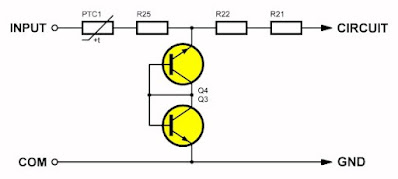 |
| The meter's protection against overvoltage. (© 2023 Jos Verstraten) |
Detail of the power supply part of the circuit
As the picture below shows, a TP4055 'Standalone Linear Li-Ion Battery Charger' from China's Yushin is used. This chip charges batteries at a maximum current of 500 mA and is powered from a voltage of 5.0 V.
Note that the specimen supplied to us contains a badly soldered resistor R19!
On the top right, you can see the white LED that provides illumination.
 |
| The power supply part of the internal electronics. (© 2023 Jos Verstraten) |
The FNIRSI S1 multimeter tested
The input resistance
Strangely enough, the specifications do not mention anything about the input resistance. Yet this is a very important parameter of a multimeter when measuring voltages. The input resistance loads the measuring point and if this resistance is too low, the meter will measure a lower voltage than is actually present at the measuring point without measurement.
A good multimeter has an input resistance when measuring DC voltage of at least 10 MΩ.
We measured the input resistance of our specimen by inserting our reference multimeter ET3255 from East Tester, switched to measuring DC current, in series with the positive test lead. Afterwards, we set up a DC voltage until our S1 indicated a voltage of 10.00 V. The ET3255 then indicates a current of 0.996 μA. So according to ohm's law, the input resistance is pretty close to the desired 10 MΩ.

Accuracy of measuring DC voltages

Accuracy of measuring DC voltages
According to the specifications, the S1 has a maximum deviation of ±(0.8% + 3) when measuring DC voltages. We checked this by measuring various DC voltages with the S1 and with our reference meter 8842A from Fluke. The results are shown in the table below.
 |
| Accuracy of measuring DC voltage. (© 2023 Jos Verstraten) |
Accuracy of measuring AC voltages
According to the specs, the S1 has the same accuracy at AC and DC voltages. We check this at a frequency of 1 kHz and sine signals generated by our function generator DG1022 from Rigol. As a reference meter, we use East Tester's ET3255. Since such a function generator obviously does not deliver high voltages, we also test the S1 when measuring the mains voltage via an isolation transformer. The results are again summarised in the table below.
What is noticeable in these measurements is that the frequency measurement in the secondary display first starts at an input voltage of about 1.8 Vrms.
 |
| Accuracy of measuring AC voltage. (© 2023 Jos Verstraten) |
The bandwidth of measuring AC voltage
According to the specs, the meter measures AC voltages with frequencies from 50 Hz to 1 kHz. We check this by supplying a sine wave voltage of 1.00 Vrms to the S1 and varying the frequency. The results again in a table:
Accuracy of the rms value
According to its specifications, the S1 is a 'true RMS' meter. This means that it measures the rms value of an AC voltage, regardless of its shape. Just to refresh your theoretical knowledge: the rms value of an AC voltage is equal to the value of a DC voltage that generates the same average thermal power in a pure ohmic resistor as the AC voltage you are measuring. We test this again with our DG1022 function generator from Rigol, which is configurable to generate the rms value of the output voltage. We measure at 1 kHz and 1.00 Vrms and check this with our ET3255 from East Tester.
The accuracy of measuring resistances
Also for this parameter, the specified accuracy is ±(0.8% + 3) to 1 MΩ. For this test, we have at our disposal a set of resistors with a tolerance of ±0.1%. To judge the accuracy for extremely high resistance values, we use an ordinary 10 MΩ resistor with a tolerance of ±5 %. As a reference meter, we obviously use Fluke's 8842A. The results, again summarised in a table:
The accuracy of measuring capacitors
As usual, the specified accuracy when measuring capacitors is a lot lower: ±(4.5% + 5). For non-electrolytics we use a set of capacitors with a tolerance of ±1%, for electrolytics we use standard capacitors with the well-known very large deviations.
What is immediately noticeable is that the S1 measures very quickly. With non-electrolytics, the meter is stabilised after about two seconds. With electrolytics it is a bit slower, even up to ten seconds with capacitors over 1,000 μF. As a reference meter, we use East Tester's ET4401 four-wire meter. Again, we collect the results conveniently in a table:
 |
Bandwidth of measuring AC voltage. (© 2023 Jos Verstraten) |
Accuracy of the rms value
According to its specifications, the S1 is a 'true RMS' meter. This means that it measures the rms value of an AC voltage, regardless of its shape. Just to refresh your theoretical knowledge: the rms value of an AC voltage is equal to the value of a DC voltage that generates the same average thermal power in a pure ohmic resistor as the AC voltage you are measuring. We test this again with our DG1022 function generator from Rigol, which is configurable to generate the rms value of the output voltage. We measure at 1 kHz and 1.00 Vrms and check this with our ET3255 from East Tester.
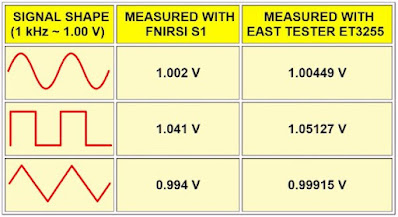 |
| Accuracy of rms value.(© 2023 Jos Verstraten) |
The accuracy of measuring resistances
Also for this parameter, the specified accuracy is ±(0.8% + 3) to 1 MΩ. For this test, we have at our disposal a set of resistors with a tolerance of ±0.1%. To judge the accuracy for extremely high resistance values, we use an ordinary 10 MΩ resistor with a tolerance of ±5 %. As a reference meter, we obviously use Fluke's 8842A. The results, again summarised in a table:
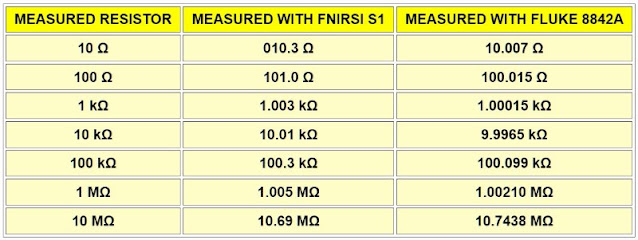 |
| Accuracy of measuring resistors. (© 2023 Jos Verstraten) |
The accuracy of measuring capacitors
As usual, the specified accuracy when measuring capacitors is a lot lower: ±(4.5% + 5). For non-electrolytics we use a set of capacitors with a tolerance of ±1%, for electrolytics we use standard capacitors with the well-known very large deviations.
What is immediately noticeable is that the S1 measures very quickly. With non-electrolytics, the meter is stabilised after about two seconds. With electrolytics it is a bit slower, even up to ten seconds with capacitors over 1,000 μF. As a reference meter, we use East Tester's ET4401 four-wire meter. Again, we collect the results conveniently in a table:
 |
| Accuracy of measuring capacitors. (© 2023 Jos Verstraten) |
The accuracy and sensitivity of measuring frequencies
In the table below, we have combined two measurements. The accuracy of measuring frequencies and the minimum rms voltage required to obtain a stable frequency reading. Again, we measure with a sinusoidal voltage.
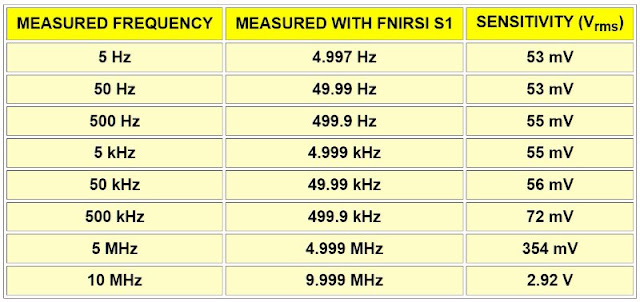 |
| Accuracy and sensitivity of measuring frequencies. (© 2023 Jos Verstraten) |
Our opinion of the FNIRSI S1 multimeter
We would call the S1 a 'fashion conscious' multimeter. 'Fashion conscious' because the design goes along with the trend of hand-held devices resembling a smartphone. However, is the S1 worth its price? For a price of 30 euros, you can buy a lot of multimeters that measure currents and have a 'REL' function and/or a 'MIN/MAX' function. Moreover, there are meters that have a more sensitive range than 9.999 V.
The only extra useful thing about the S1 is its rechargeable battery, as most multimeters work with non-rechargeable batteries that sometimes run out of power at the most undesirable times. A wall outlet and a USB charger can always be found near the measurements.
In terms of measurement accuracy, the S1 meets most of its specifications. You can trust this device to measure voltages, resistances and frequencies almost flawlessly. But that too is a feature that many identically priced meters have.
So FNIRSI's S1 will be purchased mainly for its fashionable appearance. Indeed, we can imagine that a lot of technicians will fall in love with this nice-to-handle, smartphone-like and easy-to-operate little meter and would love to get it as their second (or third) multimeter for that affordable price.

